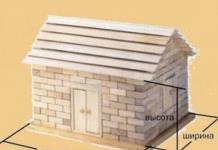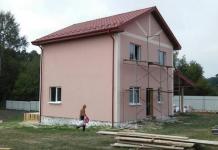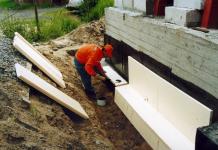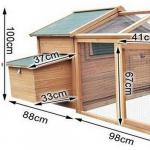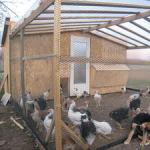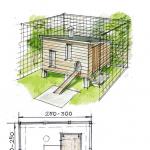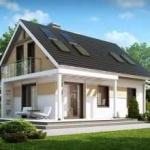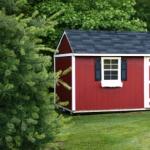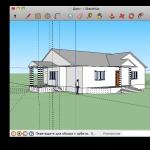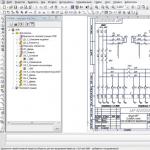I wanted to show what happened on the scanned paper, but it is so filthy and shameful that it’s a horror in general (((In general, I’ll tell you how, after long ordeals and choosing various programs, Google Sketchup won.
The program turned out to be so simple and flexible that you can draw almost anything in it. You can download it completely free. The site provides a lot of usefulness in the form of a library of three-dimensional shapes and lessons. From useful I will pay attention to video tutorials. They are in English, but it's not scary.
The translation is certainly clumsy in places, but in general you can understand. there would be a desire.
So what happened to me. House from several angles.



In sketchup, you can make a very convenient cut at home, for this there is a special tool. On the cut you can see the location of the rooms. Clockwise starting from the boiler room (the smallest dead-end room with a separate entrance from the street), then two bedrooms, a bathroom just below, even lower a living room in which it will later be decided to make an additional window, to the left of the vestibule to isolate the house from winter drafts, even more to the left is the third a bedroom and where a staircase is drawn - a kitchen with a separate, summer exit not a veranda. The staircase is just drawn on the project, in real life it will not be, as well as the second floor.
You, dear readers, have learned that the Google SketchUp program is designed for quick 3D design of architecture, landscape design, interiors, etc. What exactly can be created with Google SketchUp 8.0, and where can it be used at home? Consider one of the examples of using the program to create a project for the reconstruction of the roof of a residential building. The project provides for the replacement of asbestos-cement sheets with metal tiles with the addition of additional structural elements of the roof.
The changes were caused by the expansion of the living space due to the construction of another attic-type room in the attic, and for better illumination of the room, it is necessary to make dormer windows in the roof. At the same time, it should be taken into account that the location and design of the dormer windows should not disturb the overall harmony of the existing building.
In this case, the Google SketchUp program is simply indispensable, because. allows you to quickly implement the author's ideas without long training and make the necessary adjustments to the built-in elements of the roof, choose a combination of colors for the walls and roof. But, before you begin to perform all the tasks, you first need to have a 3D project of an existing house.

Consider, using this example, in what sequence the 3D model of the house was built, on which the conceived ideas will subsequently be implemented.

To begin with, the construction of the foundation on which the house will stand was carried out with tools Rectangle And Pull/Push. The dimensions of the rectangle were entered from the keyboard in the lower right window Dimension indicators.

Tool Roulette marking lines were laid off from the edges of the base.

Along the contour of marking lines with a tool Rectangle a rectangle was built with sides equal to the length and width of the house, and with a tool Pull/Push he pulled up. Please note that during model building, the dimensions are reflected in the window Dimension indicators and can always be corrected by entering the desired numbers from the keyboard.

Then Roulette the ridge marking line and the marking line of the transition from the roof of the house to the roof of the fence were postponed. Tool Line two lines were drawn along the marking parallel to the green axis, after which the instrument Move the ridge line rose up, and the extreme line of the roof slope of the fence fell down.

The transition from the closed porch to the garage and the roof overhangs were done with tools Roulette, Line and pushed - Pull/Push.

The same tools were used to display the buildings adjacent to the opposite side of the house.

On the facade of the building, the design of the porch was carried out. The contours were drawn with tools Rectangle, Line And Arc, and unnecessary segments were removed Eraser. The entrance was pressed with a tool Pull/Push, and the upper lines of inclined surfaces - with a tool moving.

Then Roulette marking lines were laid aside for building windows on the facade. Tool Rectangle the contour of the window was performed, and the tool Bias- Frame outline.

The marking lines marked the bindings of the frames, and the tool Rectangle six rectangles were built inside the contours of the marking lines. These rectangles depicted the contours of the glass in the frame.

Tool Pull/Push the window casing stretched outward, and the contours of the glass were slightly pressed inwards. The finished window image was selected with the tool Choose. With this tool, when the mouse button is pressed, the window is enclosed in a rectangle. After releasing the mouse button, all window outlines turn blue. Next, holding down the button on the keyboard ctrl, the mouse pointer captures the selected window and moves a copy of the window to the space allotted to it. As you can see, everything is simple, and you do not need to draw repeated elements repeatedly.

Similarly, the construction of windows on the side wall of the house and the attic was carried out.
In one of the next issues on the site http: // site, the story of the creation of the first project on Google SketchUp will be continued.
Post Views:
1 611
I wanted to show what happened on the scanned paper, but it is so filthy and shameful that it’s a horror in general (((In general, I’ll tell you how, after long ordeals and choosing various programs, Google Sketchup won.
The program turned out to be so simple and flexible that you can draw almost anything in it. You can download it completely free. The site provides a lot of usefulness in the form of a library of three-dimensional shapes and lessons. From useful I will pay attention to video tutorials. They are in English, but it's not scary.
The translation is certainly clumsy in places, but in general you can understand. there would be a desire.
So what happened to me. House from several angles.



In sketchup, you can make a very convenient cut at home, for this there is a special tool. On the cut you can see the location of the rooms. Clockwise starting from the boiler room (the smallest dead-end room with a separate entrance from the street), then two bedrooms, a bathroom just below, even lower a living room in which it will later be decided to make an additional window, to the left of the vestibule to isolate the house from winter drafts, even more to the left is the third a bedroom and where a staircase is drawn - a kitchen with a separate, summer exit not a veranda. The staircase is just drawn on the project, in real life it will not be, as well as the second floor.
The frame house projects in SketchUp, which are given in this subsection, were made by me in different years and serve only as examples. For some of the houses, only models were made, for the rest, full drawings were made. You can download an example project. In this section, projects of frame houses are laid out for free download.
On the net you can find free access to sample projects in SketchUp. To do this, type in Google in the search line "3D warehouse". On this portal, elements of houses, components, groups, simple houses with different rendering of details are freely available. Also, on specialized forums, models of varying degrees of readiness are laid out.
It is difficult to meet a normal full-fledged project on the net. To work with a project that you managed to download for free, it must be properly organized inside:
1) elements are grouped into layers
2) components and groups are given names
3) the same type of materials were used
What is all this for? The fact is that an ordinary frame house consists of several thousand components. One group or layer obscures the others. To upload drawings, and even more so for costing materials, you need a well-organized model. Otherwise, it will take you time to put it in order, comparable to drawing the same project again.
Should I look for a free example of a frame house. Just as an example, yes. As a basis for your home - no. A normally organized model of a frame house without drawings in SketchUp costs several thousand rubles. Learning how to upload drawings to LayOut or even just export pictures with dimensions from a finished model is not difficult.
One more question - why do I design frame houses in SketchUp? The answer is simple - for the design solutions section, this is the best program that is on the market. I work in SketchUp Pro, which has a number of advanced features compared to the free SketchUp. For the architectural solutions section, CAD programs are better suited. For some of the projects, I work in the Chief Architect program, which I use in the USA and Canada to design frame houses. This is a very good program for automatic design. However, only a professional carpenter can work with the Chief Architect's drawings, who does not need to apply the step of each rack and sections of typical nodes. All components in this program are merged together and cannot be detailed. In SketchUp, you can take out and show separately even a nail in a board. Therefore, I often have to draw a project in two programs so that the finished product meets the expectations and requirements of the customer and builders.
